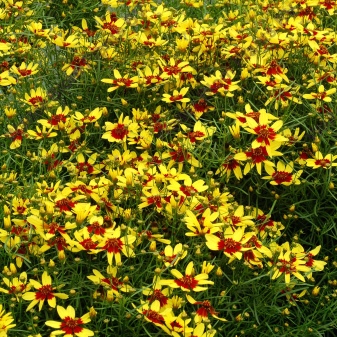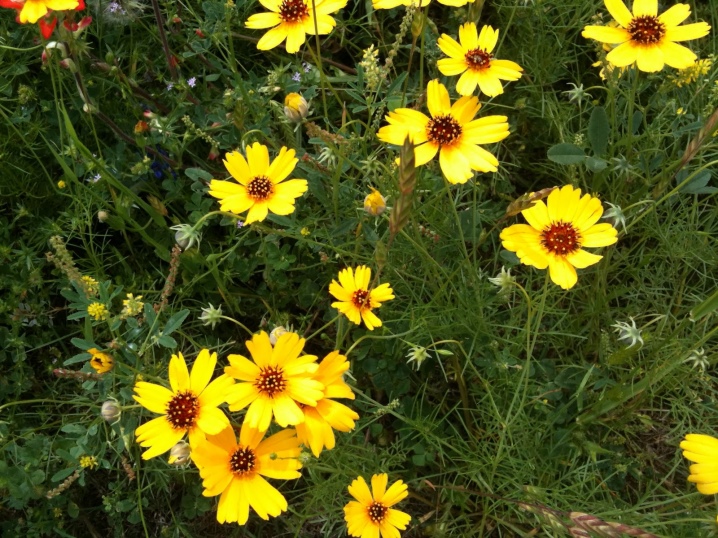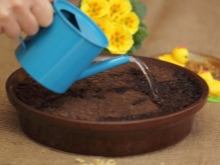Coreopsis whorled: varieties, planting and care

Today, a huge assortment of decorative flowers is presented for modern summer residents. A special place among them is the whorled coreopsis. It is an unpretentious, hardy perennial that will decorate any site with its presence.


Description
Coreopsis whorled is a herbaceous perennial whose height ranges from 50 to 90 cm. This captivating flower belongs to the Astrov family. Coreopsis is highly regarded in landscape design. Gardeners choose noble flowers for their unpretentiousness and high frost resistance.


The homeland of this plant is North America. However, some varieties of whorled coreopsis grow in Africa. In the wild, perennials are most commonly seen along highways. The features of the plant include the following characteristics:
- ligulate inflorescences, colored yellow;
- light green foliage;
- plant height reaches 1 meter;
- flowering period - from June to October.


Many gardeners confuse this variety with chamomile, since outwardly coreopsis is very similar to it. Designers call the perennial plant "garden sun" for its rich yellow hue. Coreopsis whorled grows in one place for 3 to 5 years. Prefers open, sunny places with loose, drained soil. Butterflies love him, and he also attracts the attention of herbivorous wild animals.

Note that this variety does not tolerate waterlogged soil, therefore it is not recommended to plant it near groundwater.
Popular varieties
Among the varieties of verticulata coreopsis, the following have won the special love of gardeners.
- "Grandiflora" (large-flowered). It is a tall variety with large, rich yellow flowers. Differs in unpretentiousness and high frost resistance. Combines harmoniously with other ornamental plants and conifers. It tolerates summer heat well.
- Moonbeam. A short shrub with delicate gray-yellow flowers. Suitable for small areas. Experienced gardeners recommend updating the bush of this variety every 3-4 years.
- Zagreb. The captivating lemon-colored flower is suitable for decorating summer cottages and city squares. It perfectly tolerates low temperatures and unfavorable weather conditions (gusty wind, snowfall and rain with hail). This variety is planted in street vases or containers.



Planting and leaving
Growing whorled coreopsis is a simple matter. First of all, you need to decide on the place. "Sunny" flowers prefer open areas. However, some species are planted near tall trees, since a little shade will still not harm them. Planting the plant is carried out directly in the open ground or using the seedling method.
The perennial is not afraid of low temperatures, so the seeds are lowered into the soil in early spring or autumn. A plant planted in this way will bloom only after a year, so it is advisable to use seedlings. Thus, with the onset of heat, seeds are laid out in a container with fertile soil. Then they are covered with a mixture of sand and earth and watered with water. To create a greenhouse environment, the boxes are covered with plastic wrap.



Also, many gardeners plant seeds of whorled coreopsis in peat tablets.
The plant is grown in a dry, light place. The temperature should not be lower than 15 degrees Celsius. The soil is periodically moistened with a spray bottle.As soon as the first shoots appear, the film is removed. After 2 weeks, picking of seedlings is carried out. As soon as the plant reaches a height of 10-12 cm, then it is placed in special containers. The next stage is planting seedlings in a permanent "habitat".
Coreopsis whorled is a rather unpretentious plant. However, some control over it is still necessary. A captivating perennial needs regular watering, feeding and pest control. In the sultry summer, perennials are watered 1-2 times a week. Fertilizers are applied during the growing season and after pruning (in the fall). In addition, the soil needs regular loosening, and do not forget about removing weeds.


As for wintering, with the arrival of cold weather, the bush is shortened (1/4). In the northern regions, coreopsis is completely dug out of open ground and planted in special containers.
If the temperature allows, then the plant is covered with dry foliage or spruce branches.
Disease and pest control
To the ailments that can hit this graceful perennial include:
- fungal infections;
- rust;
- spotting.
At the first signs of a disease, the foliage is best cut off, and the plant itself must be treated with fungicides. As for pests, most often they are aphids, beetles and caterpillars. Aphids provoke the appearance of dark spots on foliage and buds.
In this case, the plant is treated with a solution of potassium permanganate.

Gardeners usually remove beetles by hand.
Reproduction
In addition to seeds, coreopsis verticulata propagated by cuttings or dividing the bush... As for the first method, it is relevant in early spring, when cuttings are cut from young shoots. If we are talking about dividing a bush, then it must be carefully dug up and divided into several parts. Next, it is worth planting plants in pre-prepared holes. The distance between the bushes should not be less than 30-40 cm. In most cases, a perennial propagated in this way takes root and blooms in the first year.


Review of verticular coreopsis in the video.







































































































The comment was sent successfully.